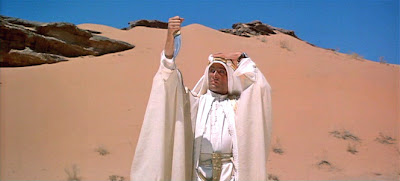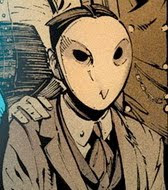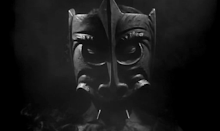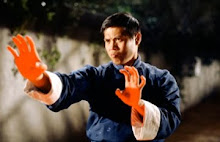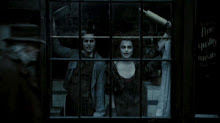The central image of Lawrence Of Arabia is of great crowds of people looking at Lawrence. Sometimes they look in awe, sometimes in fear, sometimes in admiration, sometimes in out and out hostility. But never once does anyone look at him with comprehension. David Lean usually considered the most square and establishment of filmmakers turned in a remarkably subversive film. It is an easy thing and not an altogether remarkable thing to make your hero a charmless thug and crow about your revisionism. It is quite another to make a heroic epic that manages to call the entire concept of heroism into question.
Yes amazingly up until now I had never seen Lawrence Of Arabia. It was just one of those holes, every movie geek has a couple, that I never managed to fill. It wasn’t anything malicious, and I always figured I’d get to it one day. It’s just that Lean wasn’t terribly in vogue when I was cutting my teeth as a cinephile. There wasn’t any urgency. What can I say that wouldn’t be the first dumb mistake I’ve made.
This really should be the worst possible time to watch Lawrence Of Arabia anyway. It is after all at its core a story of Western intervention in the Middle East. Made at a time when most westerners fervently wish that the concept of intervening in The Middle East was still entirely foreign to them (When Rains says the line “On the whole I wish I’d stayed in Wales.” the laugh he got had the distinct ring of commiseration). But like all great cinema Lawrence Of Arabia stands out of time. Perhaps that is the test of truly great film. From the opening images on it’s impossible to judge Lawrence by any standards but its own. Art forces you to accept things on arts terms.
It helps that Lean presents Arabia in a way that goes beyond mere exoticism. Arabia ceases to be foreign and becomes down right alien. The ceaseless bleached white vistas, the rocks that dwarf the human characters, the ever shifting sands and winds.. Everything, from the crazy grace of the camels, to the clothes to the architecture takes on a new aura and significance. Blown to eye shattering proportions on an immaculate 70 mm print it becomes in its own strange the world’s most photorealistic sci fi film.
There are of course all the things that usually get talked about that make the film remarkable. It’s incredible scope, the sheer beauty of Lean’s cinematography, the cast which includes such pleasurable ringers as Alec Guinness, Anthony Quinn and Claude Rains, as well as the debut of the unbelievably charismatic Omar Sharif.
Just as alien is the figure at the center. Of course some of this “strangeness” is a bit easier to parse now than it was fifty years ago. I’ve often heard about the “ambiguity” of O’Toole’s sexuality in the film. Let me tell you there’s nothing ambiguous about it. Short of indulging in a cabaret number it’s tough to tell what more Lean and O’Toole could have done to telegraph that Lawrence is flagrantly DC. And yet the crucial thing, the thing that makes the film not just ahead of its time but in many respects ahead of ours, is the way that the film instinctively understands that this explains nothing at all. Lawrence’s sexuality is only one aspect of the character. It adds to his outsider status but it doesn’t define it. To say “Well that explains the enigma, he’s gay.” Is no more helpful than to say “Well that explains him, he’s straight.”
From frame one the film is dedicated to you not knowing Lawrence. He's obscured first in an overhead shot, then through a pair of insectile road goggles. When we finally do meet him face to face it’s after the man is already dead and buried. In the rest of the film he’s mercurial, messianic, fey (at one point actually skipping across a courtyard) and barbarous, in equal measure. In one of the film’s most famous shots upon reaching The Suez Canal (providing a shot of Steamship traveling across the desert that I can’t help but wonder got Herzog’s wheels turning) a British officer on the other side bellows out “Who Are You?” to a dazed Lawrence. A look of horror quickly spreads across Lawrence’s face. At first glance this would seem to be an example of being a bit on the nose. But that’s only if you consider the question from one angle.
You see, I think the horror is not a result of Lawrence realizing he doesn’t know who he is. I think he is horrified by the fact that he knows exactly who he is. He is a man who marched into the desert and found himself waiting for him. “Nothing is written.” He says in one of the movies most awe inspiring moments. Nothing. Except perhaps character. The one thing we can’t escape.
Who is Lawrence? Who’s to say? All we see is the poetic image of the shadow dancing across the sand.
(Postscript: To the three to four douchebags who sat behind me at The Paramount and snickered like Jr. High School Girls for three hours before I finally snapped. Congratulations, you are officially above the movie or something, and the entire back half of the Paramount Theater got to see evidence of that fact.
Next time you want to prove you're too cool for a movie rent it, and then make snarky comments about it when you return it to the video clerk. Don't spoil a 70mm revival screening with your rudeness. If it's too much to ask that you have a little taste, at least have a little respect. The cinema is a church.)

